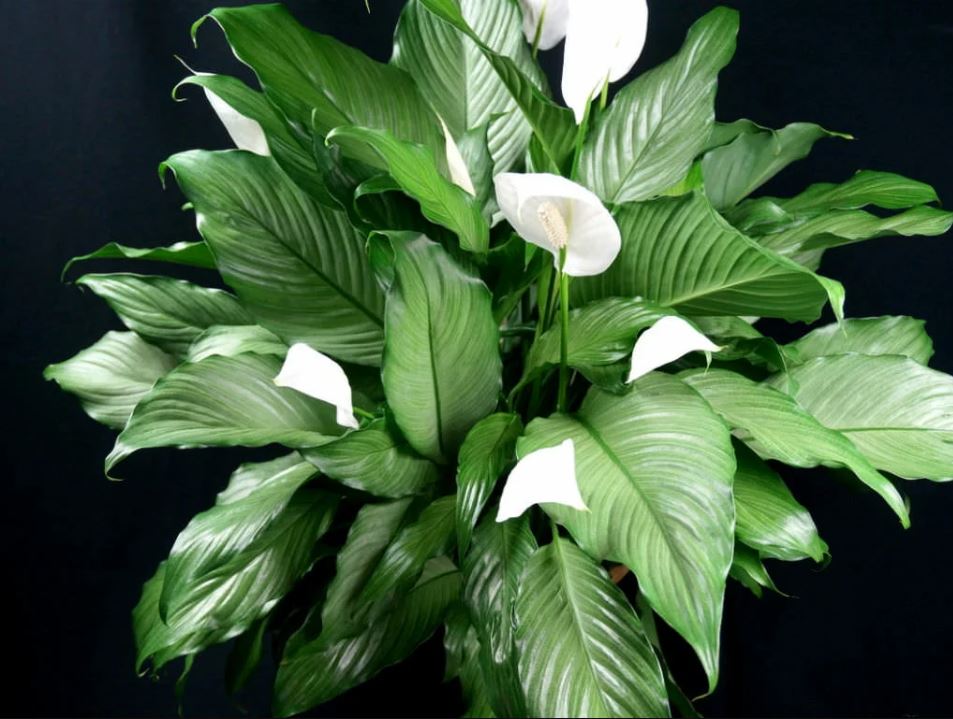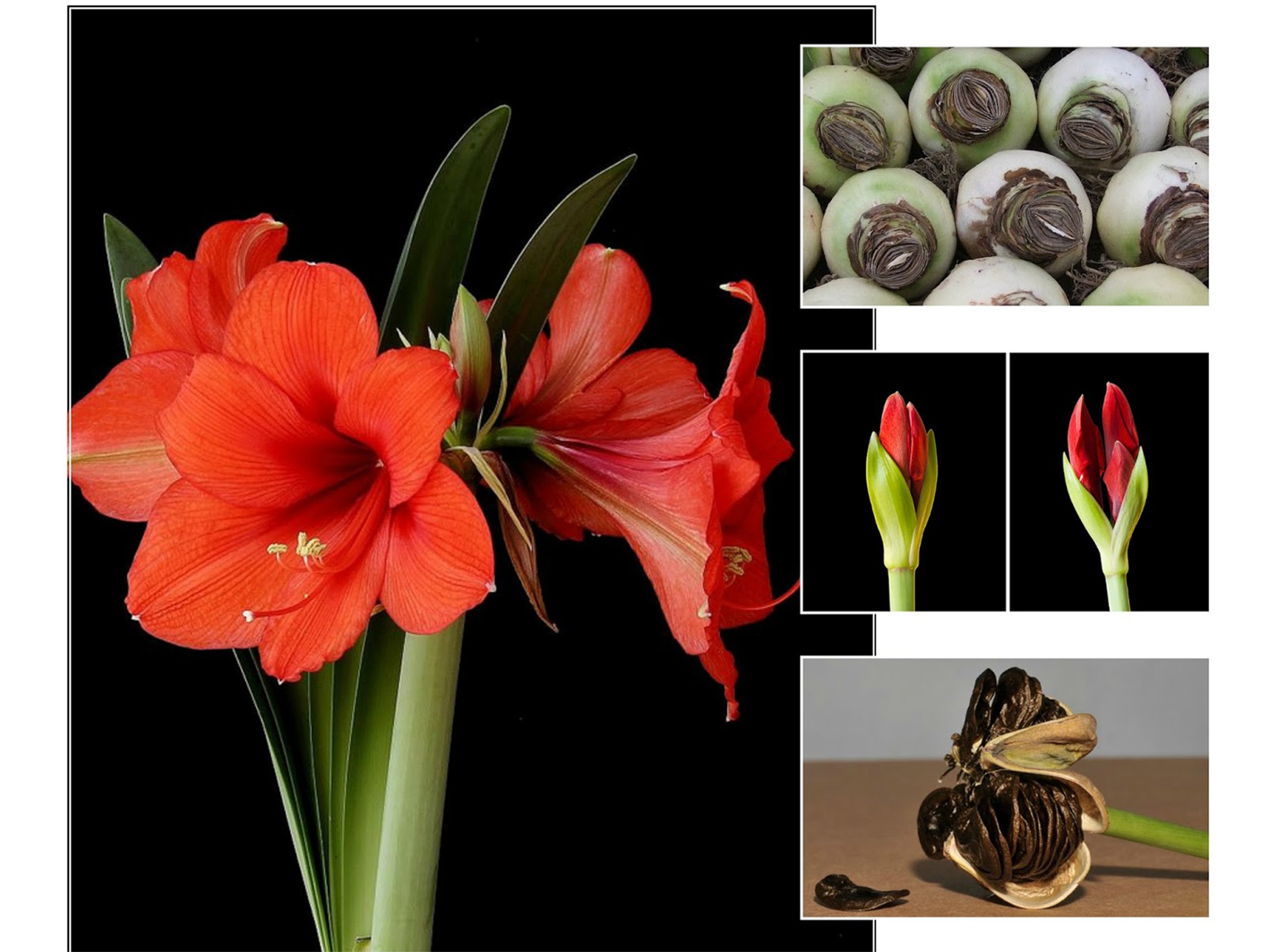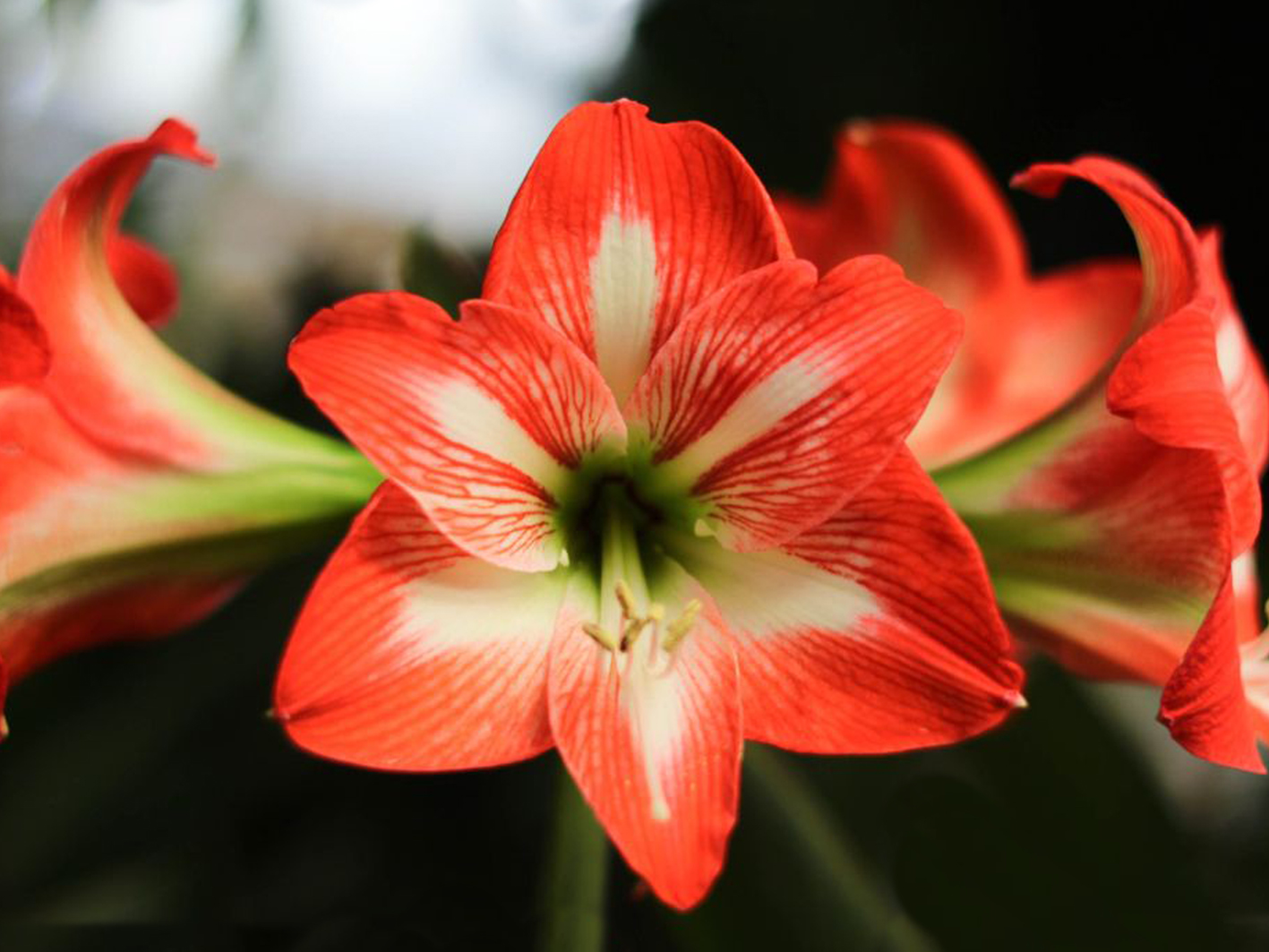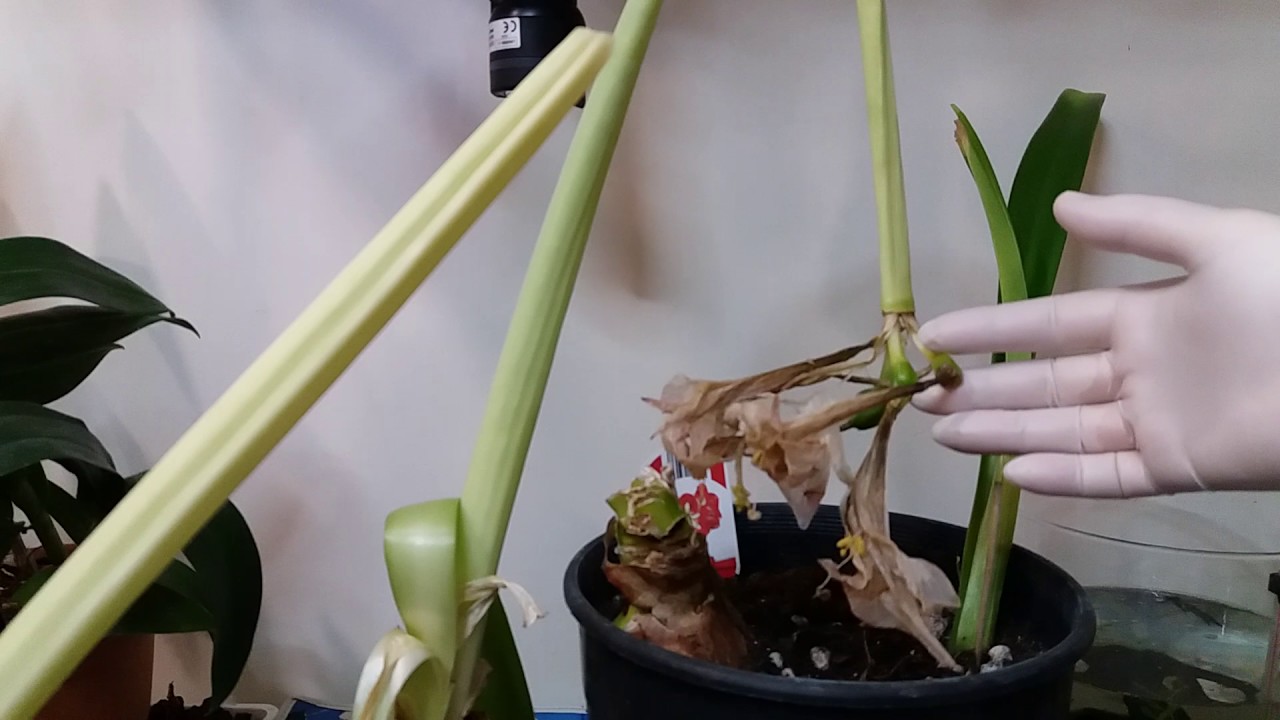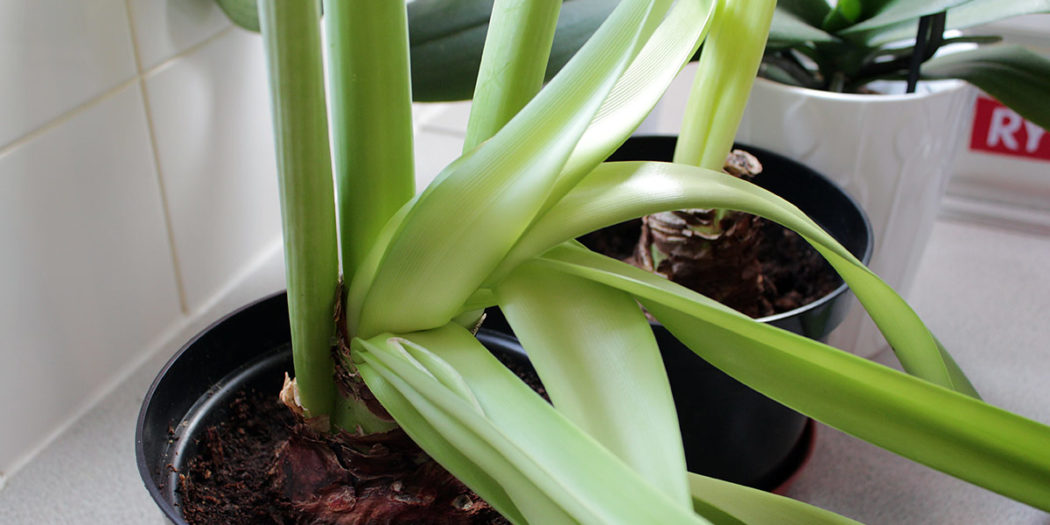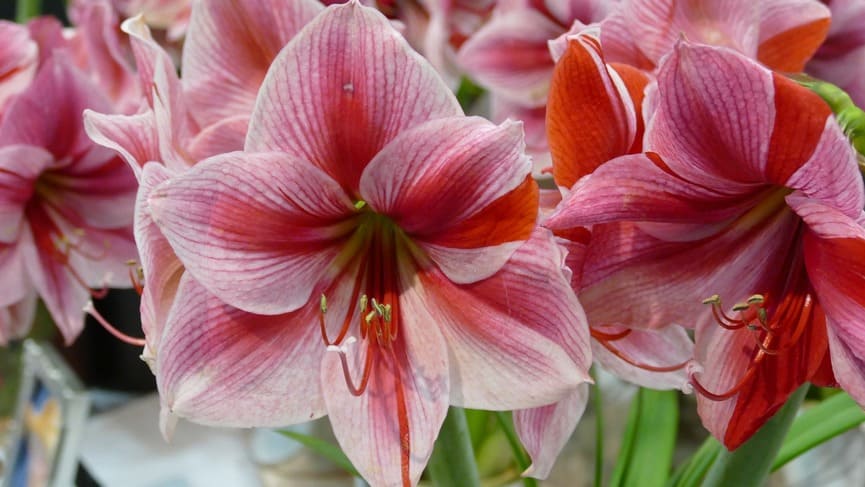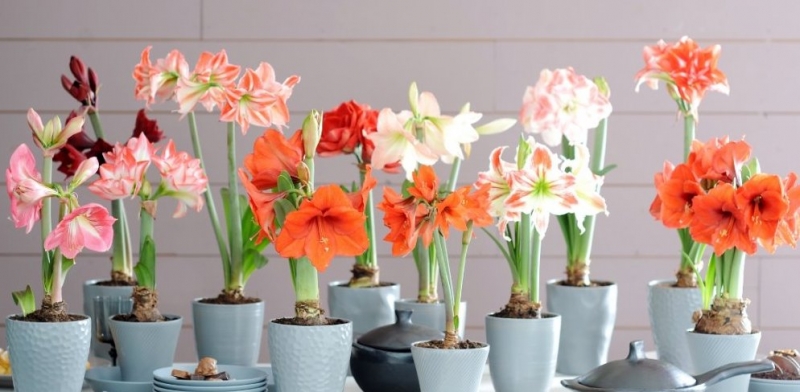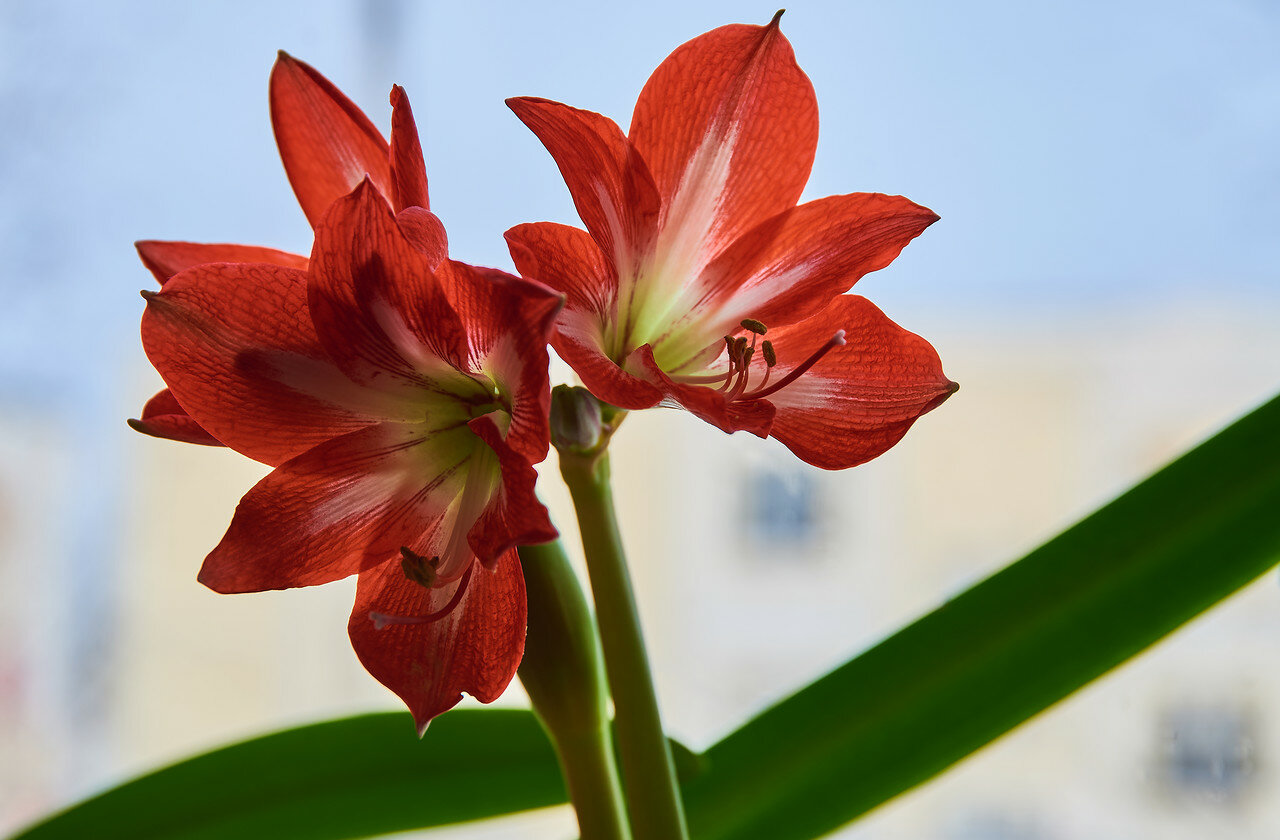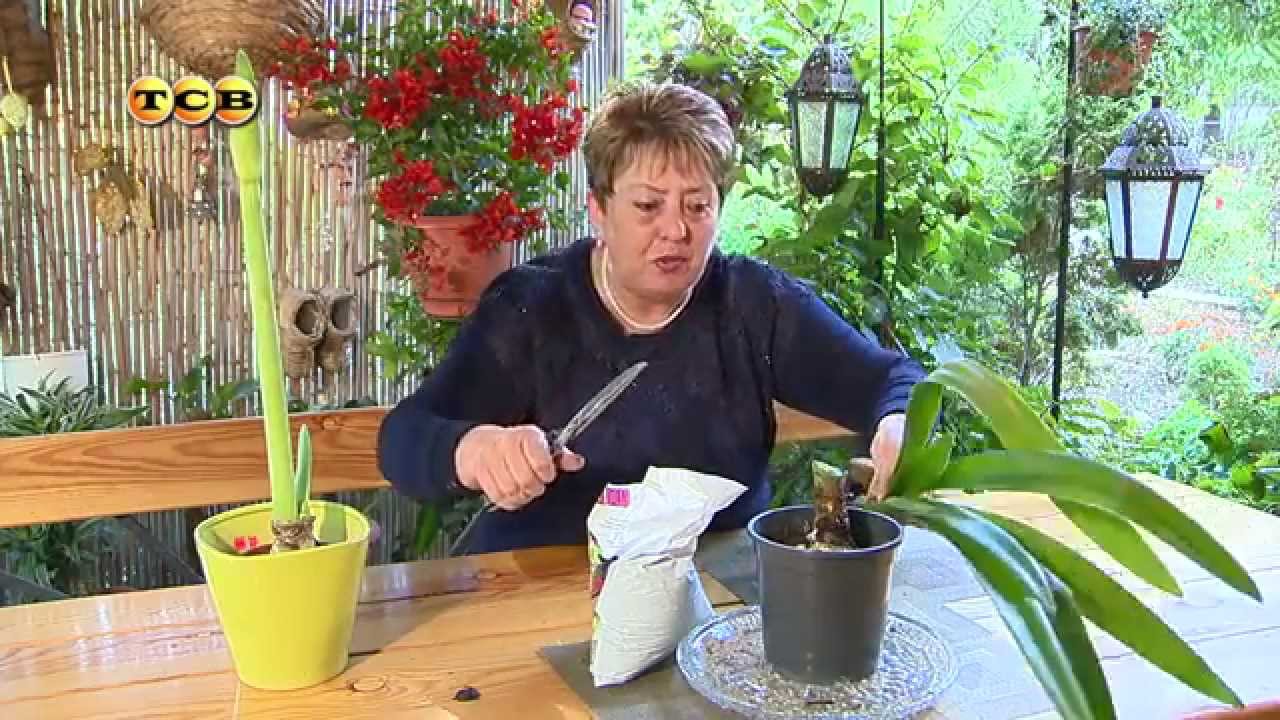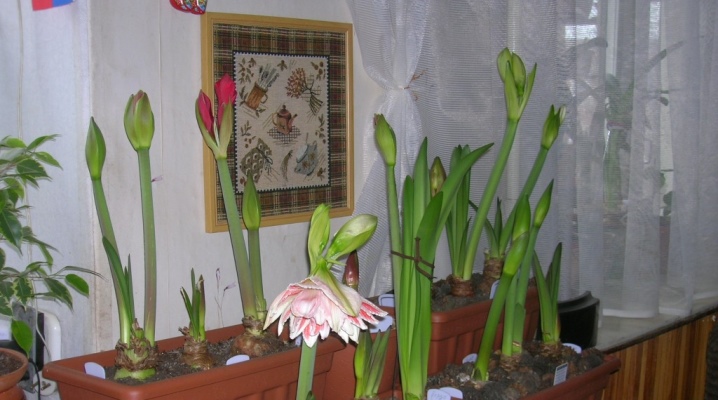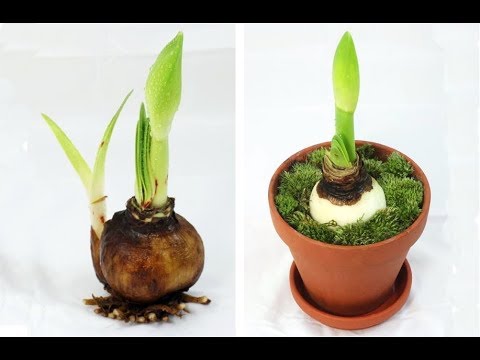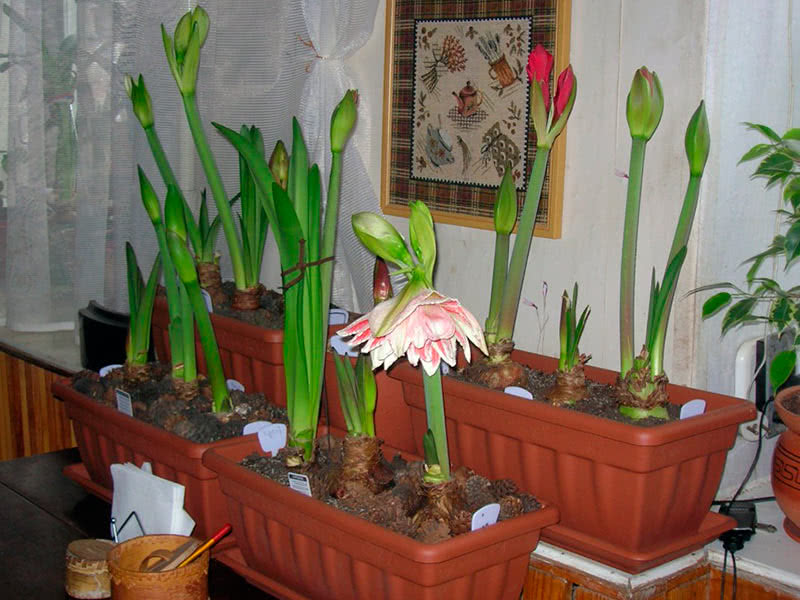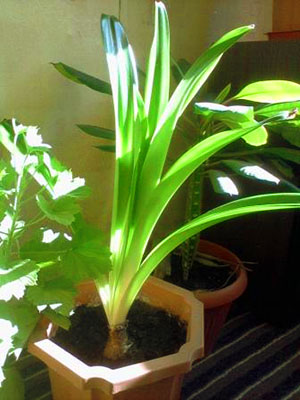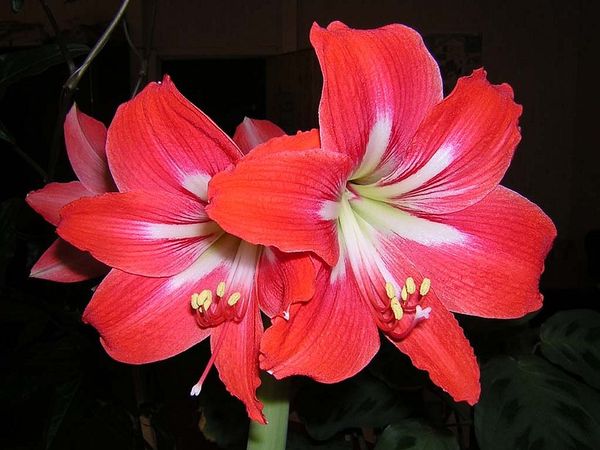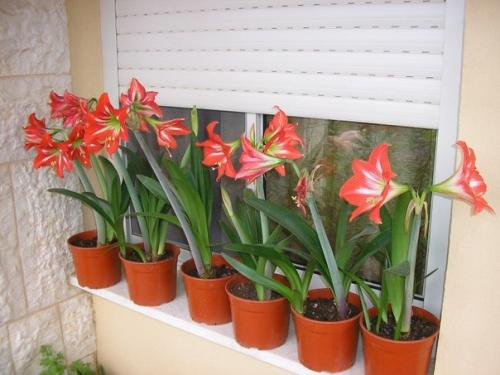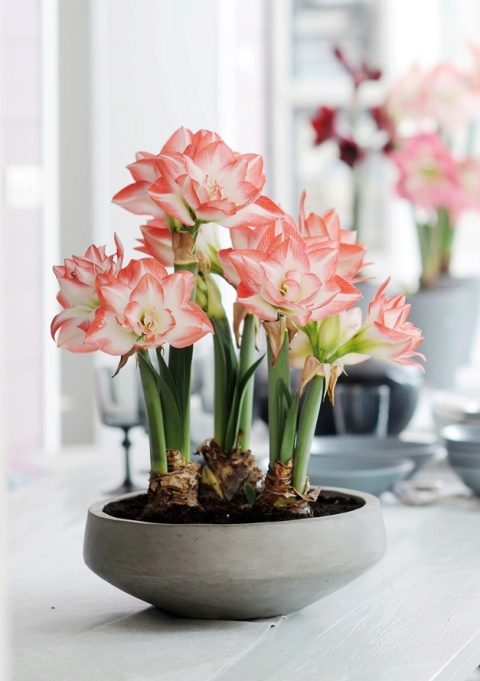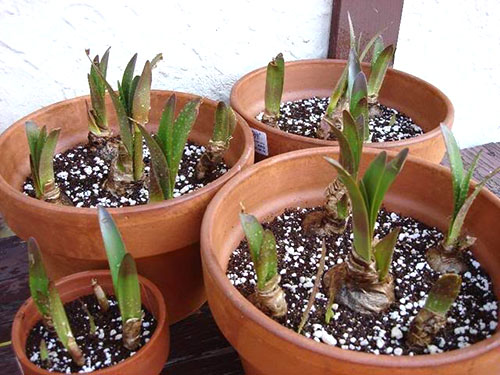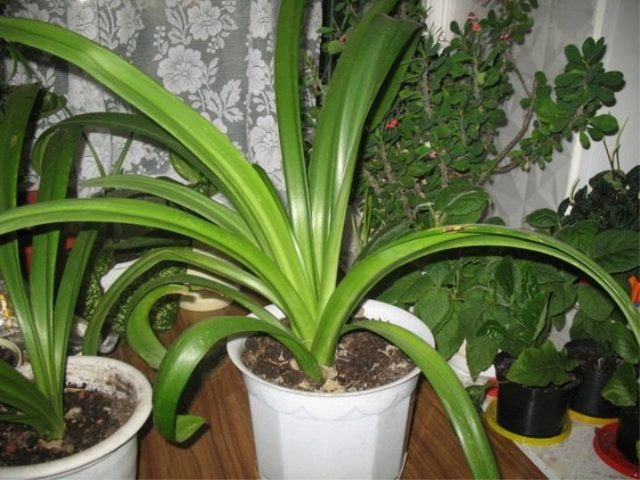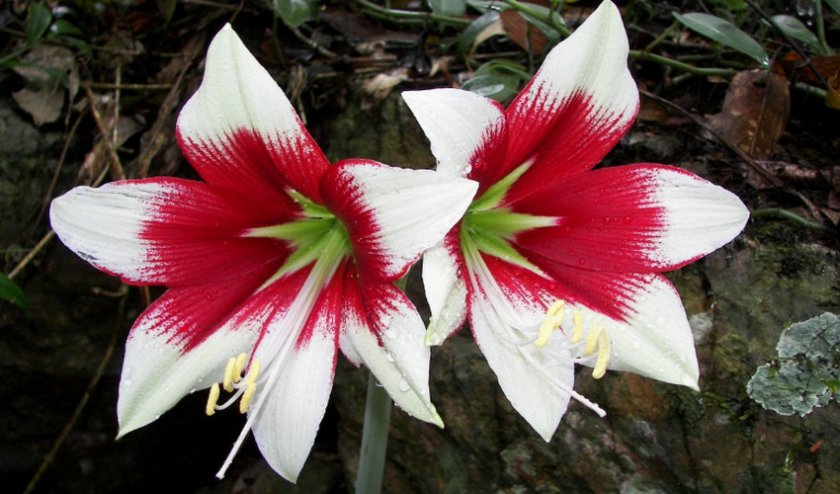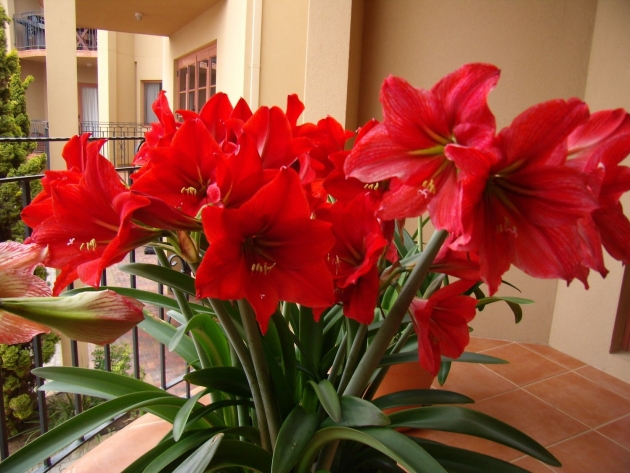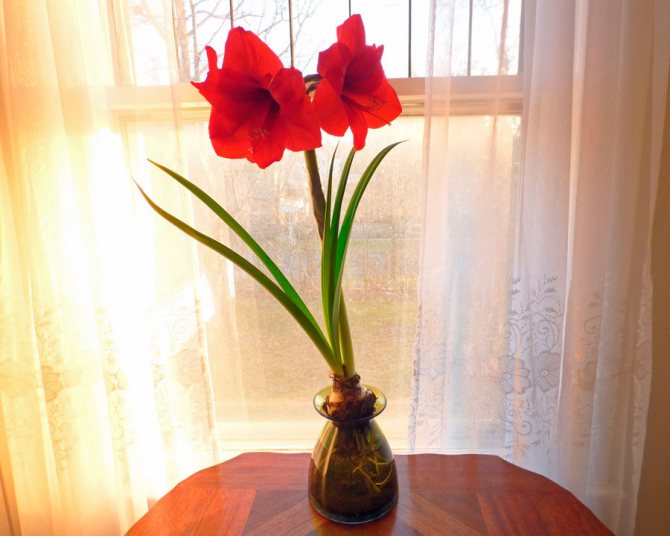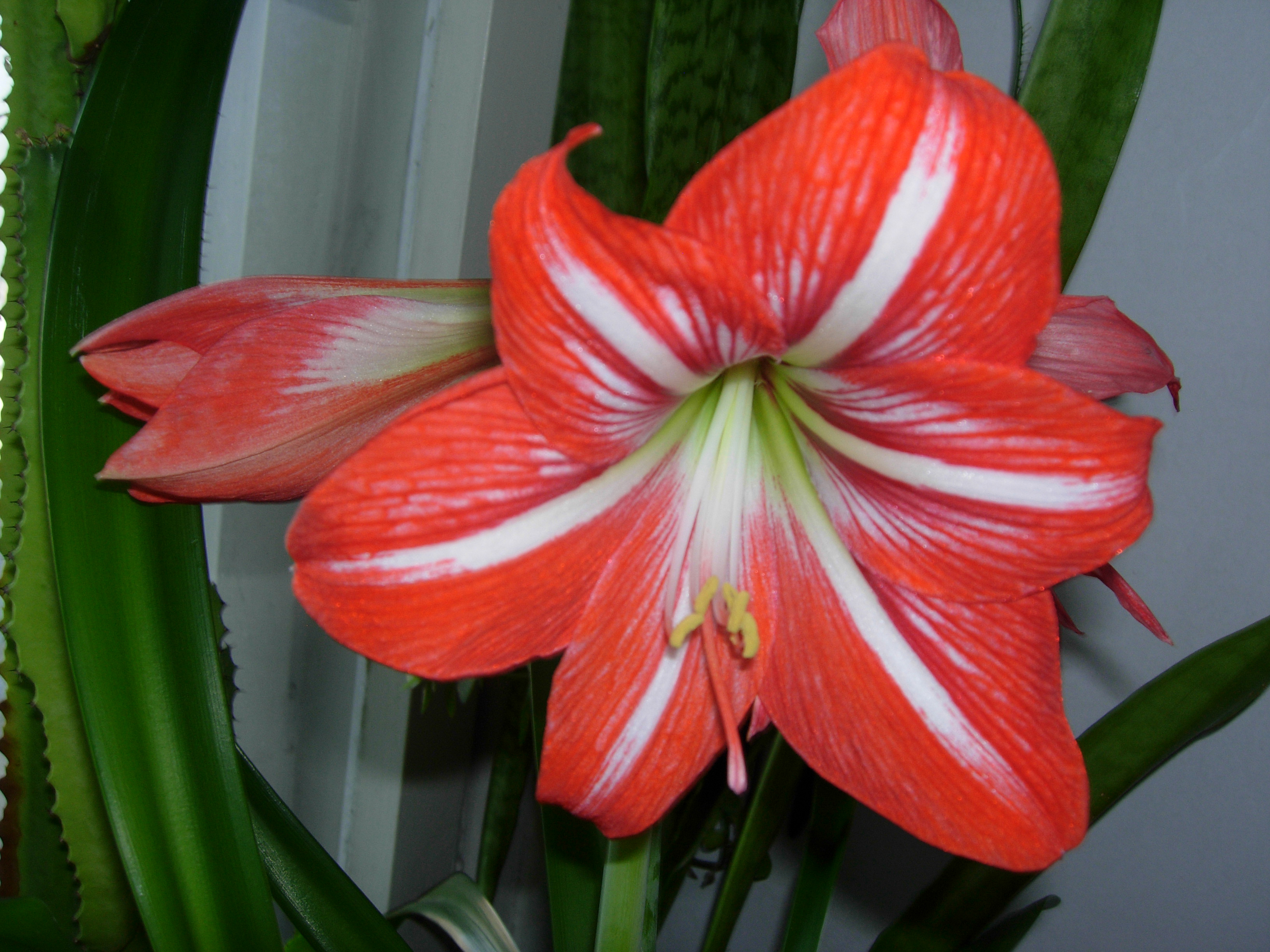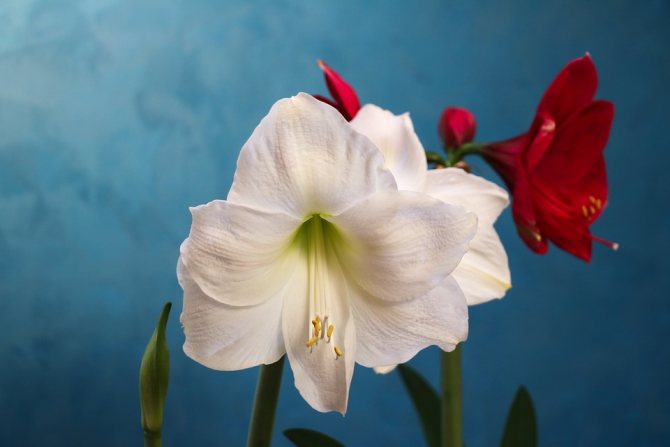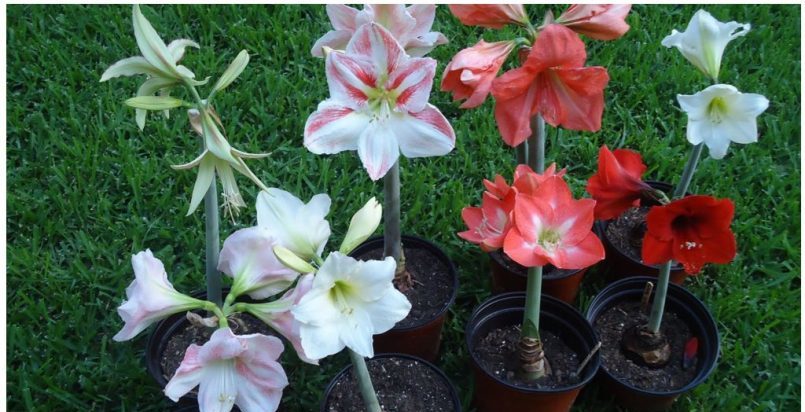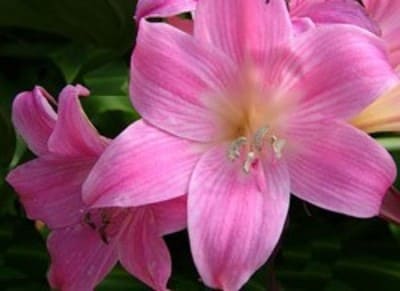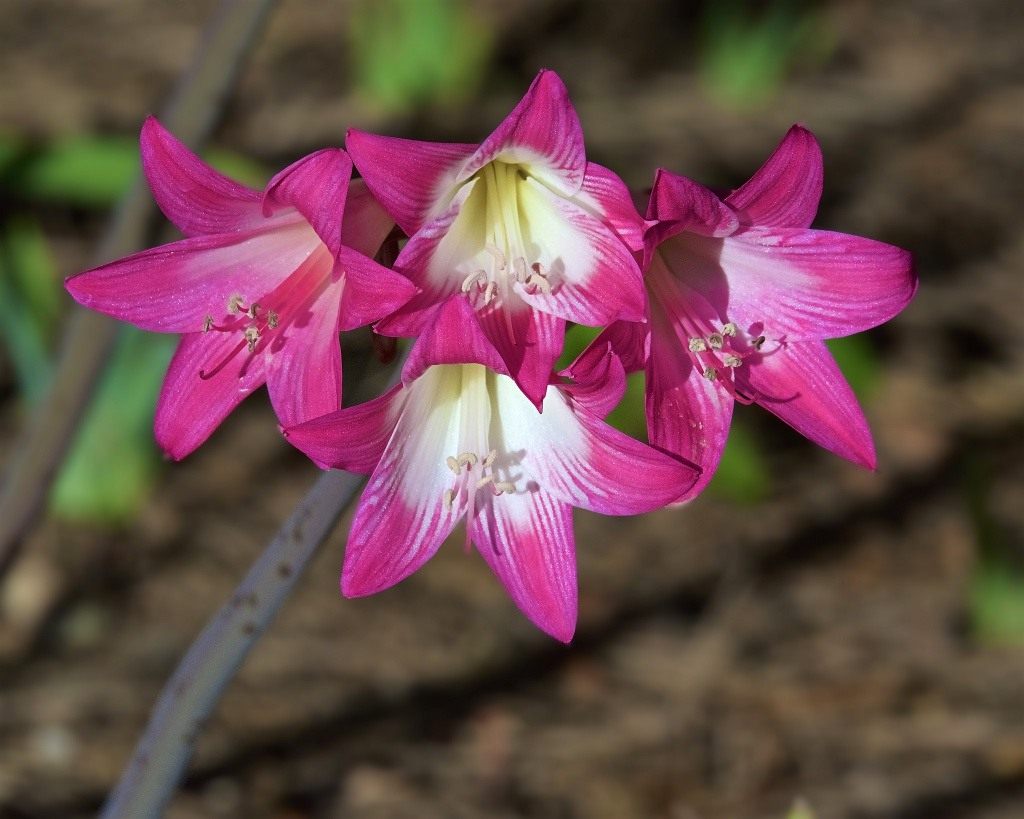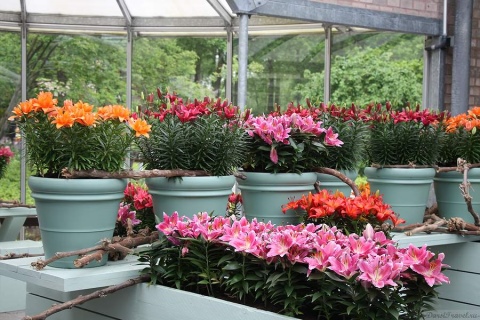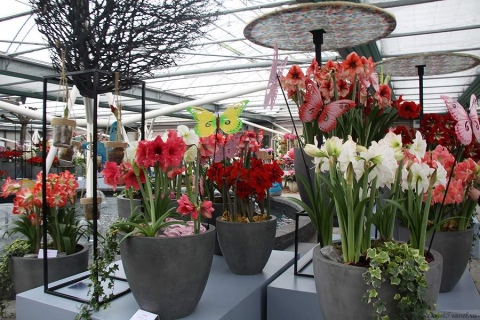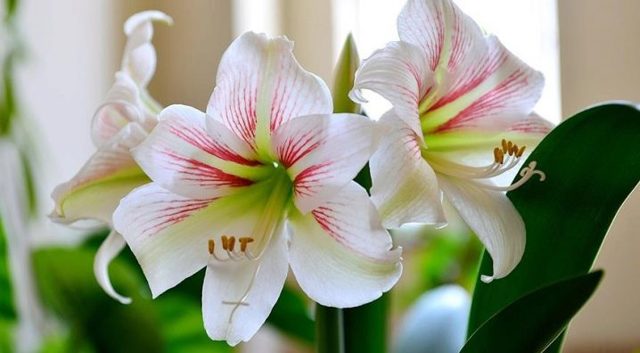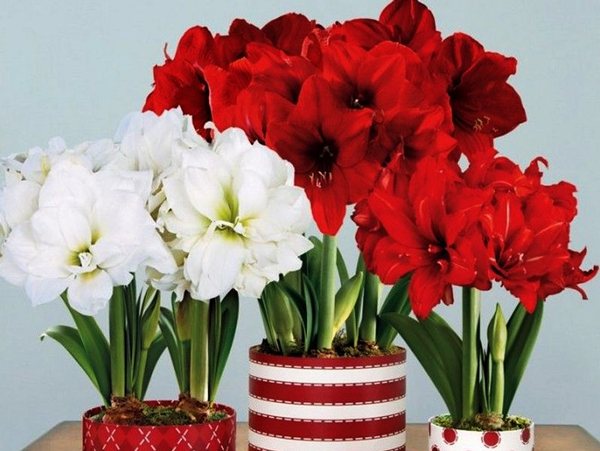Correct Amaryllis Content
So, if amaryllis is provided with normal home care, why doesn't it bloom? Here are the factors that need to be considered for the full development of amaryllis:
- Lighting. This plant can and should be placed where there is bright sunlight. If natural light is not enough, you need to take care of artificial lighting. If the flower is on a south window, shading will be required from noon to 3 pm during the summer months.
- Humidity. Amaryllis do not like wet rooms. You can not flood the plant and allow stagnant water, in addition, you need to water closer to the edge of the pot and make sure that water does not fall on the neck of the bulb and leaves. Spraying is also impossible.
- Temperature. When forcing and flowering indoors, the temperature should be in the range of 19-24 degrees Celsius, it is undesirable to go beyond these limits. Water for irrigation must be warm, room temperature.
- Top dressing. Approximately once every two weeks, during the entire growing season, the plant needs mineral fertilizers; complex fertilizers are suitable for flowering plants.
- Rest period. It is not advisable to "wake up" the plant earlier than after 3 months of rest. Ideally, it should be alone for 5 months.
An analysis of the actual conditions of detention will help to understand where the mistake was made. After that, it will be necessary to adjust the attitude towards the flower and the next year the amaryllis will probably bloom.
In general, amaryllis cannot be called completely unpretentious, but the flower does not require anything super complicated either. If you take care of it, following the above recommendations, you can get a beautiful and stylish living decoration of your home.
vote
Article Rating
A set of rules for plant flowering
If a flower is able to delight with flowering more than once a year, every grower wants to boast of his skills of "communication" with plants and show the result. Amaryllis is not picky. There are just a few rules, in case of violation of which you will have to grab your head and look for an answer to the question "what to do?"

All positions are associated with the maximum approximation to natural growing conditions, which means that you will have to create good care for:
- bulbs (rotting roots should be removed so as not to cause rotting and other diseases on its soil);
- the safety of the flower (this even applies to the weight of the pot, so that the plant does not receive a shock from falling due to the preponderance under the weight of its own leaves and arrows);
- dormancy stage on time (from June to early September, the plant should be removed to a cool, dark place);
- alternating stages of rest and active watering, in parallel with feeding;
- flowering, making sure that there are no more than two arrows from one bulb, otherwise this will lead to the depletion of the plant;
- the beginning of flowering (in the tight space of the pot, the amaryllis releases arrows faster, and in a more free space - gives strength to the birth of "children");
- correct watering (excessive moisture intake before the release of the peduncle can go to the detriment of flowering, for that in favor of the growth of foliage);
- the same development of the plant from all sides (access to lighting on each side of the amaryllis helps the plant develop in the same way and does not provoke a distortion of the plant in either direction);
- bulbs (peduncles, so that the root system remains strong, should be cut off after flowering, and leaves that have lost their density cannot be removed, because they return the remaining nutrients to the bulb).
Amaryllis does not bloom, what should I do?
More than three hundred years ago, sailors brought amaryllis bulbs to Europe from South Africa. This exotic plant surprisingly combines delicate tubular flowers, graceful long leaves, and an unobtrusive aroma.
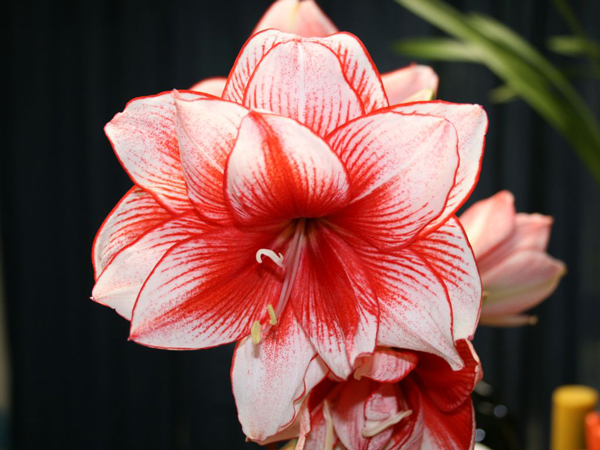
Overseas culture began to be planted in greenhouses, grown in the open field, hoping that it will delight with fragrance and beauty. Amaryllis bulbs took root easily, the bushes did not require special care, but many gardeners could not understand why the overseas guest does not bloom, but only releases only leaves.
In the wild, the conditions for the development of a culture are significantly different from those created for a plant from South Africa. In these parts, hot and dry summers, the sun always stands at its zenith, it rarely rains, but there are showers.
Optimal conditions for keeping amaryllis
In the northern latitudes, amaryllis are grown mainly at home. Florists should take into account some features that depend on whether the flower is in a phase of active growth or dormancy.
Watering amaryllis during the growth period should be moderate. When the peduncle reaches 10 cm in height, you can water the bulb abundantly, but there should be no stagnation of water. When watering, the water should not wet the bulb - only the soil surface is irrigated. In the winter months, it will be sufficient to sprinkle the soil around the bulb once a week until it is completely saturated with water 1 cm deep.
From the moment the first flower stalk blooms, it can be cut off and placed in a vase of water, which is very important to change daily. Thus, the cut flower will last up to three weeks without depleting the bulb.
This is exactly how the peduncle remaining on the plant will behave. During the flowering period, amaryllis needs a cool room with diffused lighting.
Do not leave amaryllis with faded buds, but it is not recommended to remove them until they are completely dry. With the arrival of winter cold, some leaves dry out, they must be removed. It is not recommended to completely remove the leaves; they will have to feed the bulb during sleep. Fertilization is carried out every 2 weeks from the moment the peduncle appears. When the inflorescences are fully blooming, fertilizing is applied once a week.
A good effect will be provided by dietary supplements high in potassium and phosphorus, such as:
- "Emerald";
- Bona Forte;
- "Ideal";
- Agricola;
- "Living World";
- "Florist";
- "Bud";
- Kemira Lux;
- "Rainbow";
- "The Power of Life".
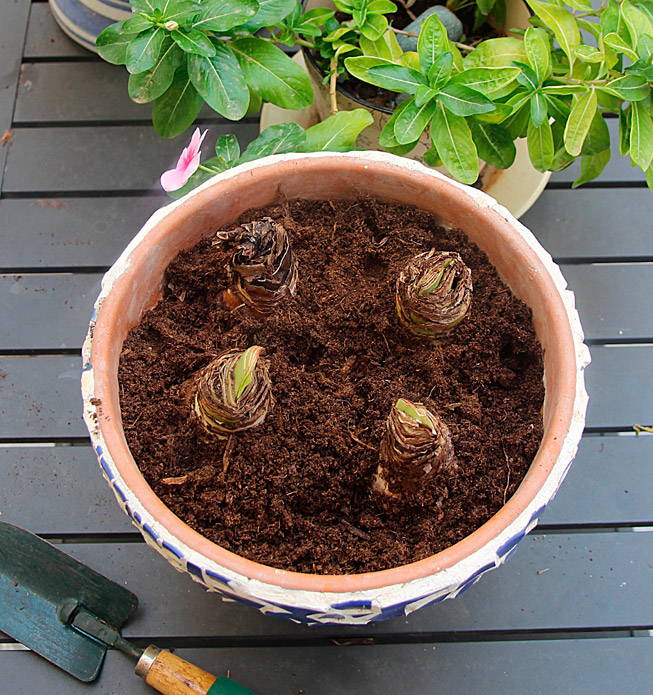
As soon as the leaves completely wither, the fertilization is stopped - the plant is preparing for wintering. During the dormant period, it is recommended to keep the amaryllis pot in a cool and shaded place. Some growers prefer to dig up amaryllis bulbs for the winter and store them in dry cardboard boxes until spring.
But with such storage, you need to remember that the bulbs should not dry out, so once a week they can be wrapped with wet cotton napkins.
It is very important for amaryllis to maintain dormant periods between flowering to restore the strength of the bulb. Only proper home care for amaryllis will allow it to bloom twice a year.
Therefore, it is important for beginner flower growers to consider a few simple rules:
- the pot should not be too spacious, otherwise the bulb will spend all its energy on the formation of children;
- you cannot immerse the bulb too deeply in the ground - the peduncle will not be able to form normally;
- be sure to feed, lack of nutrients will not make it possible to create buds;
- with a lack of lighting, fluorescent lamps can be used;
- if you skip rest periods, you can destroy the bulb;
- bulbs damaged by pests should not be planted in the ground until they are completely cured.
Winter dormancy in amaryllis lasts from two to three months.With the arrival of spring, pots with amaryllis are rearranged in a well-lit and warm place, connecting gradual watering to transition the plant into the phase of active growth. Amaryllis, which have already bloomed earlier, are rapidly gaining strength and growing. Young plants that have emerged from seeds will delight with their flowering in 7-8 years. Babies grown from the bulb will bloom in 3-4 years.
Diseases and pests
Amaryllis leaves begin to turn yellow when attacked by aphids. The plant suffers from thrips. These insects feed on the sap of buds and petals, forming voids. The appearance of pests leads to the fact that pollen crumbles, yellow spots form on the flowers.
The danger to the plant is carried by spider mites, daffodil fly. To cope with insects, amaryllis are sprayed with fungicides.
With an excess of moisture, an exotic culture is affected by rot. Reducing watering helps to solve the problem.
The daytime rays of the sun cause a red burn. A little shading helps prevent disease.
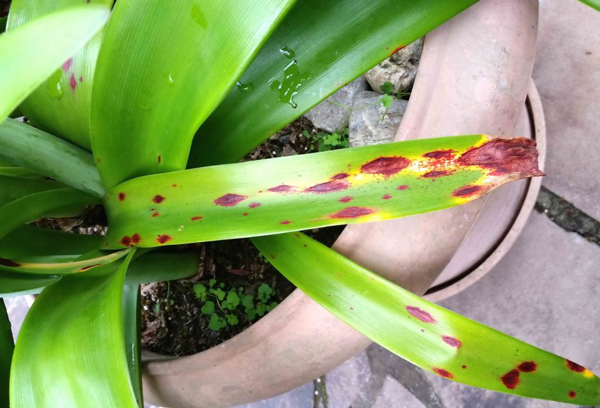
Now you also know how to make amaryllis bloom at home. We wish you success and beautiful flowers on your windowsills!
{SOURCE}
3 Growing conditions
In order for amaryllis to look healthy and beautiful, it is necessary to properly care for it and observe a number of conditions:
- 1. Location. During the growth period, sills from the southeast or southwest side are better suited. The south window can be used, but in this case you will have to darken the sunlight all the time. During the rest period, you only need a cold and dark place with good aeration. As for lighting, during the active growth phase, 15-16 hours of light will be needed. If necessary, for additional lighting near the pot, you can put or hang a lamp - phyto- or luminescent. It must be borne in mind that the peculiarity of the amaryllis is that it constantly reaches for the light. To prevent this, the container with the flower must be turned on a different side each time for uniform development of the plantings. Props are also needed. During the rest period, lighting is not required at all.
- 2. Air humidity. Amaryllis is a moisture-loving crop, so it is recommended to spray the area around and over the flower. You can pour small stones into a wide pallet and periodically moisten them with water. Or put a pot of water that will evaporate.
- 3. Ventilation. The room must be regularly ventilated, but the pot with the plant must not be placed in a draft.
- 4. Temperature. At night, the optimal indicator will be 18 C, but during the day it should be about 23-24 C. All this applies to the growth phase, but during the rest period it is necessary to maintain the temperature at 12 C. Sharp changes should not be allowed.
- 5. Watering. During the growth period, it should be moderate. It is required to start watering from the moment when the peduncle reaches 10 cm. The plant loves moisture, but does not survive sudden changes in temperature. During planting, the soil should not be allowed to completely dry out, but overflow is also undesirable.
- 6. Top dressing. It must be done every 12-14 days. Moreover, such a procedure can only be started from the period of bud formation. When the plant is in bloom, the interval between feedings is reduced to 1 week. You can use fertilizers of a mineral complex type, which are intended for indoor flowering crops ("Emerald", "Ideal", "Power of Life", "Master Color", "Florist", "Rainbow", "Ava" and others). It is better to choose those that contain more potassium and phosphorus, rather than nitrogen. You can also use fertilizers of a natural organic type - bird droppings. It will take a third of a cup of such a product for 10 liters of water. You can use fresh manure - dissolve about 1.5 cups in 10 liters of liquid. After flowering, when the dormant period begins, there is no need to feed the flower at all.
All these conditions must be observed.
Homemade amaryllis native to South Africa
Question: "How to make amaryllis bloom?" worried many minds. The whole secret is that the plant needs to imitate conditions close to its natural ones.
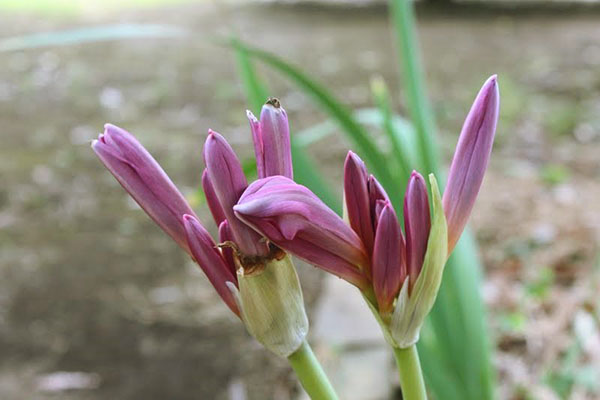 Wild amaryllis are plants with a pronounced growing season and an obligatory dormant period. The first signs of bulb activity, dormant for part of spring and all summer, appear in March, the first autumn month in the southern hemisphere. It is at this time that the rains begin, the temperature reaches a comfortable 20-25 ° C, and the rocky slopes are covered with lush inflorescences, consisting of 6-12 large pink flowers.
Wild amaryllis are plants with a pronounced growing season and an obligatory dormant period. The first signs of bulb activity, dormant for part of spring and all summer, appear in March, the first autumn month in the southern hemisphere. It is at this time that the rains begin, the temperature reaches a comfortable 20-25 ° C, and the rocky slopes are covered with lush inflorescences, consisting of 6-12 large pink flowers.
For well-being, homemade amaryllis are created with conditions similar to those that the plant had in nature:
- From the moment the peduncle is formed and until the last flower binds, the culture is watered as soon as the surface layer of the soil dries up, and twice a month fed with a complex agent.
- The interval between flowering and leaf formation is used to transplant the bulb and separate the children from it.
- Watering is reduced when foliage begins to grow, and stop when it dies.
- Amaryllis spends the rest period at a temperature of +9 ° C. The temperature is not raised until the plant shows signs of growth again.
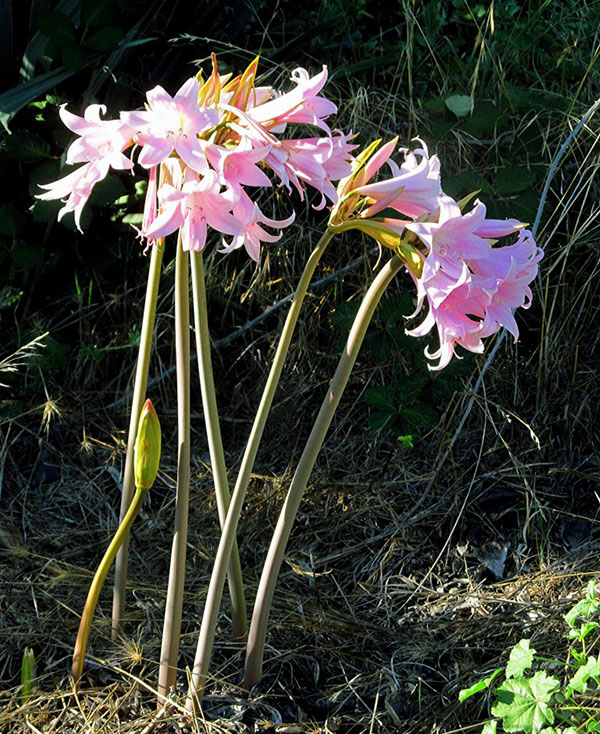 If amaryllis does not bloom, you need to understand the possible reasons for this and try to fix the situation. The buds of inflorescences in the depths of the bulb are laid at least one season before the upcoming flowering.
If amaryllis does not bloom, you need to understand the possible reasons for this and try to fix the situation. The buds of inflorescences in the depths of the bulb are laid at least one season before the upcoming flowering.
In nature, the culture prefers lighted, ventilated places with drained soil. At home, a soil mixture consisting of 2 parts of peat, the same amount of loam, one part of perlite or sand is suitable for her. A glass of bone meal is mixed into 6 liters of such a substrate and the bulb is planted so that most of it remains above the ground. At the same time, homemade amaryllis does not tolerate waterlogging, but easily tolerates drought.
2 Landing
Reproduction of amaryllis is carried out by separating daughter neoplasms from the main bulb. But reproduction by means of seeds is practically not used due to the complexity and duration of the procedure. It is imperative to choose the right pot before planting young crops. It must be stable and large. This is because the rosette and leaves of the amaryllis are very large and require space. In addition, the peduncle is very high, which is why it is unstable. Even with a slight movement, you can turn the pot along with the flower.
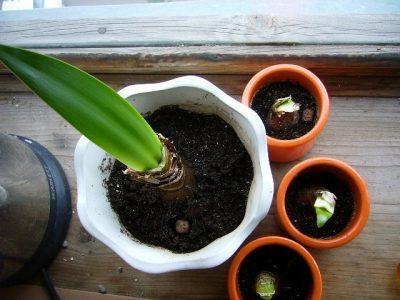
The diameter of the container depends on the size of the bulb and all the roots. The first should take up almost all the space inside the container. There should be a distance of no more than 5 cm from all sides between its walls and the bulb. Moreover, the deeper the pot, the better it is for the flower. As for the material, the best option would be unglazed ceramics so that there is sufficient aeration in the container. If it is planned to place several amaryllis in one container, then it is necessary to leave a distance of 10 cm between the bulbs.
When planting a crop, it is extremely important to choose the optimal substrate for it. It is better to choose the one that targets bulbous crops.
It can be purchased at specialized flower shops. You can also prepare the soil yourself. There are several suitable formulations:
- 1. Mix humus and turf soil in equal proportions, and then add 2 times more coarse sand.
- 2. Take peat, turf soil, garden soil, humus and sand in equal volumes.
- 3. Combine 1 part of sod land, garden soil, coarse sand and add 0.5 part of humus.
It is imperative not to forget about the drainage layer. Its thickness should be about 2-3 cm. You can use gravel, pebbles, expanded clay, chips from broken brick or slate, ceramic shards.
The transplant is as follows:
1. Select strong and healthy bulbs. Their surface should be smooth, free from dents, cracks, stains and other defects. There should be no signs of mold or rot. If an unpleasant aroma with sweet notes emanates from the bulb, then you should not plant it.
You should pay attention to the roots - they must be well developed.
2. Remove dead scales of black and brown shades from the bulb up to white and greenish layers
Immerse the planting material in a light solution of potassium permanganate for half an hour. Alternatively, you can treat with any fungicidal agent. Bordeaux liquid is an excellent option.
3. Wait about 12-24 hours after the end of disinfection until the bulbs dry out.
4. Pour drainage into the selected container (with holes on the bottom), then a small layer of sand, and then the substrate.
5. Place the onion with the blunt end down and sprinkle with soil so that its upper part is located one third above the ground. Tamp the earth.
6. Water the flower and put it in its permanent place.

It is supposed to transplant the culture only after the end of flowering, when the peduncle itself has already dried up. The procedure is recommended to be carried out every 3 years. You can do this earlier if it is already noticeable that the container has become too small for the plant. Otherwise, it is required to remove the top layer of soil 3 cm thick annually and replace it with fresh substrate.
Flowering plant
The dormant period can last until the end of May. After that, the flower buds are laid on the bulbs. The plant blooms in late summer - early autumn. The plant grows an elongated peduncle.
In length, it can reach more than 85 cm. Above is an inflorescence, on which flowers are formed. If there are too many of them, they are arranged in two tiers. The inflorescence is in the form of an umbrella, the flowers are in the form of a funnel. They have 6 petals. They reach 7-11 cm in diameter. The pistil is graceful, filiform. 6 stamens.
You can clearly appreciate how beautiful amaryllis blooms in the photo below:
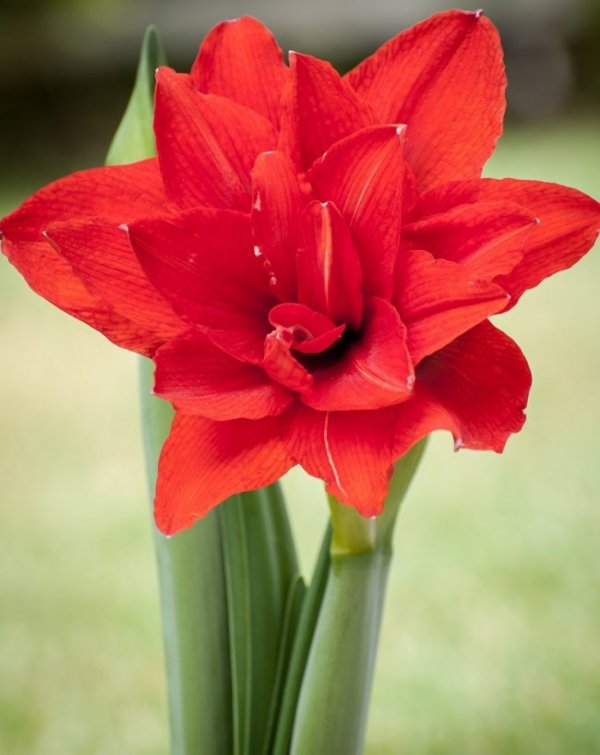
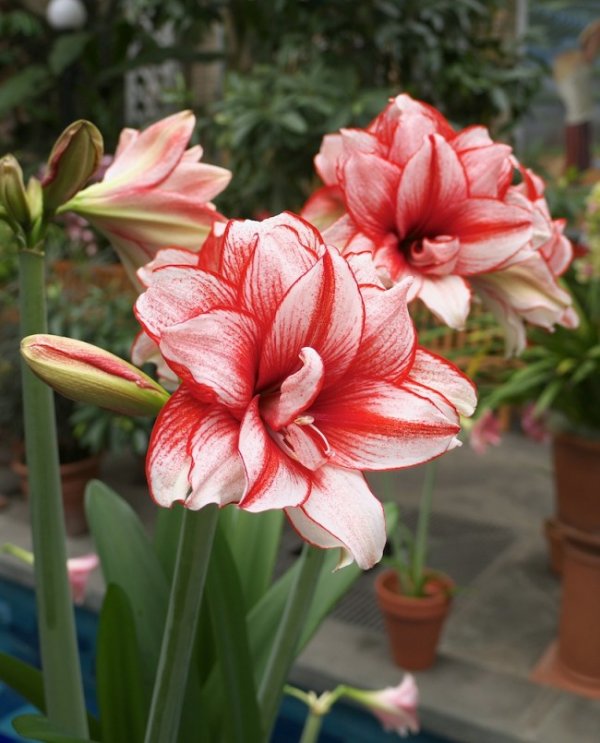
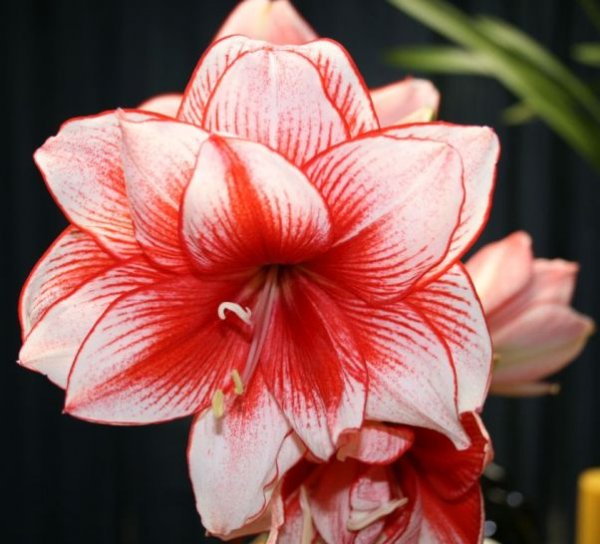


Period
Amaryllis is a bulbous flower. After planting, it begins to actively grow and throw out peduncles. After 1.5-2 months, 1-2 powerful peduncles appear on the bulbs. Each of them will bloom 5-7 magnificent flowers. To extend the flowering period, the container is kept in cold rooms without direct sunlight.
Three-fold flowering of this representative of the flora greatly degrades the bulb and leaves it almost without the necessary trace elements. After the beginning of flowering of the first flower, it is recommended to cut the peduncle immediately.
It is placed in boiled water. The water is changed daily in the dishes. The flowering period is identical when cut and on flower. But when removing the peduncle, professional growers reduce or prevent the depletion of the bulb. Correct removal also stimulates the growth of a new grower. After flowering, this representative of the flora must be provided with a dormant period.
Comfortable conditions
This is the basic requirement of the flower. If you do not take care of him according to all the rules, then you really can not wait for gorgeous flowers.
What are these rules?
As soon as the peduncle has formed and the last flower is tied, we must not forget about watering the culture.
When the upper soil layer dries up, it is important to water the amaryllis, and twice a month to arrange a combined feeding for it.
There is an interval between flowering and the formation of leaves - it is used to transplant bulbs and separate children from them.
It is recommended to reduce watering when the foliage grows. When the leaves die off, watering is complete.
The dormant period for a flower is marked by a temperature of +9
And it cannot be increased until the culture shows signs of growth again.

When planting the bulbs, a significant part of it should be left above the soil. Amaryllis will not tolerate hypermoistening, but it will be able to cope with drought.
Bloom extension
In order for the amaryllis to bloom longer, it is recommended to put the flowerpot in a cool place. There, ultraviolet light is not afraid of him. After the bud opens, the peduncle must be cut off and placed in a vase. Chronologically, the flowering of amaryllis in a vase is equal to flowering on a bulb. Usually, pruning the initial inflorescence stimulates the crop to release a new arrow.
It is also significant whether the florist acts correctly after the amaryllis flowers wither. Stop feeding the crop in September. It should be watered minimally; in October, watering stops completely. Usually at this time, the culture is actively shedding its leaves. The nutrients are sent to the bulb, and this period is the beginning of preparation for flowering.

Do not forget about all the bulbs care items. Business requires experience, skill. Novice flower growers may not know that in winter amaryllis is able to "sleep" not only in a pot, but also in a box with sawdust, that at the end of the first month of winter it is necessary to awaken the plant: this is done by high-quality watering (warm water is used).
Amaryllis. General information
Amaryllis (Latin Amaryllis) is a perennial plant with a pronounced life cycle from the Amaryllis family (Latin Amaryllidaceae). The plant owes its name to the ancient Roman poet Virgil. In his poem "Aeneid" there is a shepherdess of unearthly beauty named Amaryllis or Amaryllis, which means "sparkling".
Florists call the amaryllis "March" or "Jersey" rose. The plant came to the countries of northern latitudes from the African south from the valley of the Oliphants River in the Cape Province of South Africa. The genus was first identified by the Swedish botanist Karl Linnaeus in 1753. Prior to this, the plant was considered a type of lily.
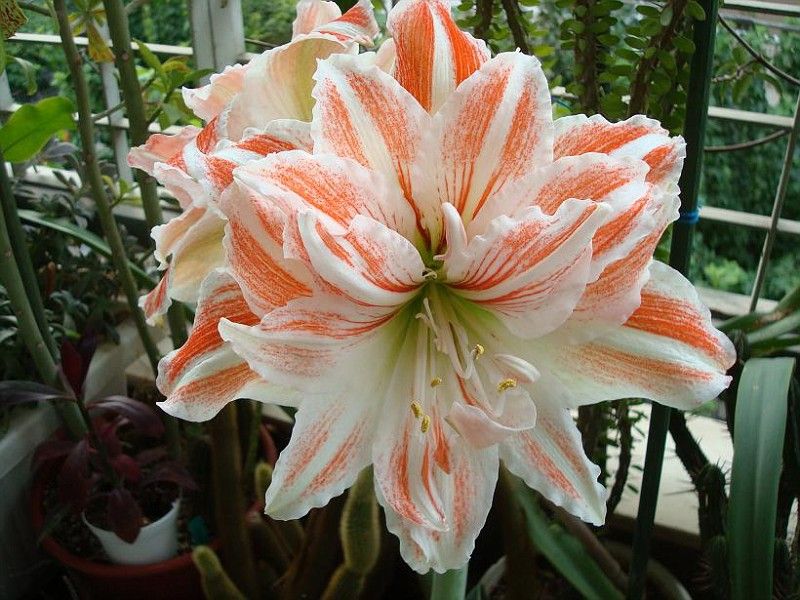
However, Linnaeus made a mistake, adding to the amaryllis and hyperastrum varieties, which are similar in many morphological characteristics. Even today, it is possible to make the mistake of buying amaryllis, which some sellers confuse with hyperastrum. Having bought hyperastrum out of ignorance, do not be upset. It will also bring joy to the owner with larger, brightly colored flowers that do not have the ability to exude scent.
In Europe, the following types of amaryllis take root well:
- Celica;
- The Snow Queen;
- Pink Nymph;
- Macarena;
- Promise;
- Merry Christmas;
- Black Pearl;
- Benfica;
- Exotic;
- Moonlight;
- Rosalie;
- Mattherhorn;
- Clown;
- Charisma;
- Prelude;
- Neon.
Amaryllis grows from large bulbs. The leaves are dark green in color, elongated, smooth to the touch, arranged in two rows. On the eve of flowering, amaryllis throws out a long peduncle in the form of a hollow shoot 40-50 cm high. Some species give 2-3 peduncles. Each peduncle has 5-10 flowers of amazing color, depending on the type of amaryllis. Thus, the inflorescences on each peduncle are like umbrellas. Following this, the first leaves appear.
To do this, the planting period of the bulbs is changed and the air temperature is increased. The first flower stalks should appear in a couple of months.
Flowering plant
In their homeland, amaryllis after the growing season rest from rapid growth. During the dormant period, the leaves fall off, and the bulb accumulates strength. In the southern hemisphere, she wakes up in March, when autumn comes with rains, the air temperature drops to 25 degrees. Lush inflorescences of a pale pink color, collected in an umbrella, appear on rocky slopes.
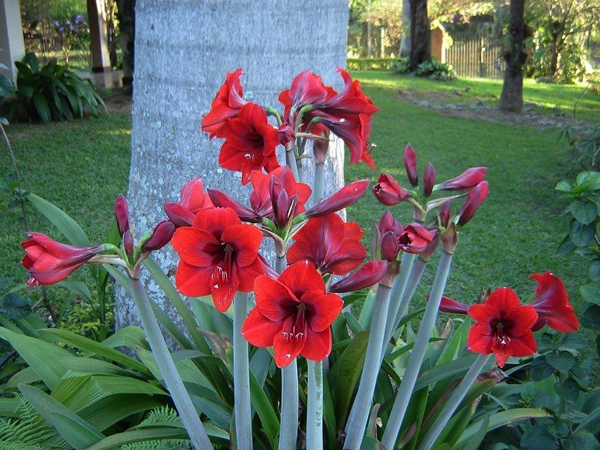
The fragrance lasts up to 2 months, after which the plant produces long leaves arranged in two rows. They will be replaced by tall peduncles again, each of which forms up to 10 buds with 6 petals.
The diameter of the blossoming flowers is more than 6 cm, they do not fade for almost a week.
Why are there no flowers?
The reason for the lack of bud formation lies in the violation of the natural order, that is, in non-observance of the flowering conditions. Among them:
placing culture in a place with insufficient temperature and humidity indicators; deepening the bulb during planting; planting in a dense substrate that will not allow the root system to grow.
Moving the amaryllis out of the shade will help to make the amaryllis bloom. Sometimes it is enough just to change the window sill, the room. If the plant does not have enough light for a long time, then the number of buds will decrease.
Another potential cause is exhaustion due to an excessive number of babies that the grower did not separate in time.

Lack of recovery
What to do in the absence of flowering?
Perhaps you have not adapted to the amaryllis cycle and do not know about the recovery period. When the inflorescences wither and the leaves appear, bulbous plants are usually stocked up with new strength. And this is done not only due to the nutrient soil components, but also due to the process of photosynthesis, which is organized by the leaves. This period is significant for Amaryllis.
But it happens that experienced flower growers are surprised at the lack of buds. “Last year,” they assure, “the amaryllis bloomed, but this year it only produces leaves.” We figure it out: usually, an adult bulb has only one peduncle. And when two strong inflorescences have developed above the soil, this can become an exorbitant load for the amaryllis. This means that the bulb, which worked fruitfully last season, failed to recover and “skips” a new flowering cycle. Amaryllis repeat this path of "forced leave" of other bulbous plants.
Young plants
By the way, perhaps your plant is still too young. If it is less than 3–6 years old, it may not have enough resources to bud bud. At home, such "young" plants do not go into hibernation, therefore they are kept warm all year round, fed and watered. And if the onion receives competent care, if the owner does not forget to feed and water it, then you should not worry about flowering.
Unsuitable pot
The case may also be in the container for the flower. It should be tall and narrow. The correct choice can be made in this way: if two fingers passed between the onion and the walls of the pot, then this is sufficient width. The stability of the flowerpot is also important, because the plant has a heavy peduncle, the flowers are also large.
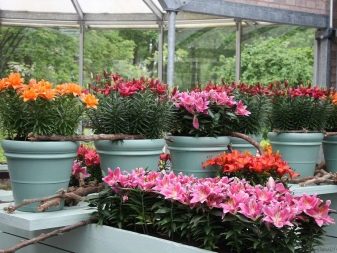

Weak bulb
If the bulb is still young or just weak, the appearance of flowers can also not wait. After the flowering of the bush, the bulb is actively gaining strength, it accumulates nutrients and useful components. The larger the bulb, the higher the chances that the new season for amaryllis will be successful.
Choose for planting only a healthy bulb with a diameter of 8–10 cm. If you notice deformed roots (dried out and rotten) on the bulb, they should be removed.
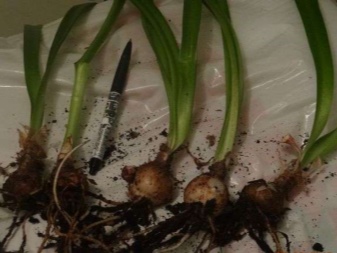

What difficulties are possible?
The owner himself does not always notice that the conditions that are important for growing crops have changed. The temperature regime cannot exceed 24 degrees. But even during the flowering period, it should not fall below 19 degrees. Without organizing such conditions, amaryllis can weaken, shedding buds.
And one more thing: during the watering period, some growers do it forwarded, defective, as a result of which the top layer of the soil may remain dry. It is also imperative to spray the flower with warm water from a spray bottle.
Amaryllis is a beautiful plant; there is no equal to it during the flowering period. It looks perfect in a gift bouquet, and just as an interior decoration. Therefore, careful care and some capriciousness is a tribute equivalent to a chic flowering. When purchasing amaryllis, be prepared to study information about it - the flower will not survive if the grower is not "armed" with knowledge.
You can see the planting of amaryllis in the video below.
{SOURCE}
Why doesn't homemade amaryllis bloom?
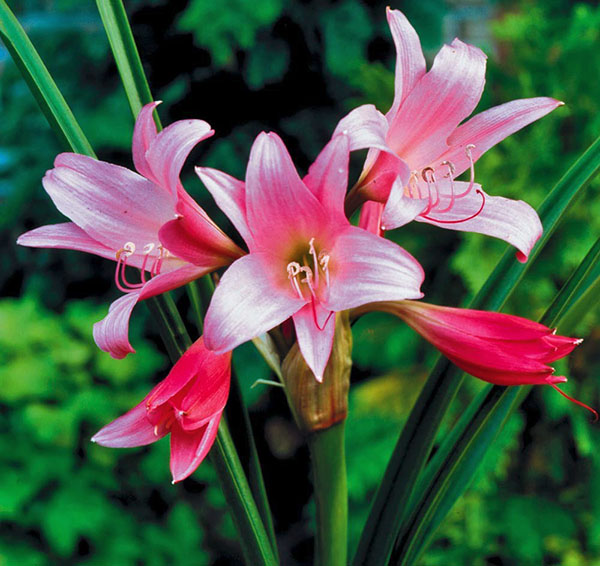 From distant countries, Italian, Spanish and Portuguese sailors carried outlandish plants, jewelry and spices. So, in 1714, amaryllis bulbs first came to Europe.At first, tall flower stalks appeared above the planted plants, then pink tubular amaryllis flowers opened on their tops, and the entire surrounding space was enveloped in floral fragrance.
From distant countries, Italian, Spanish and Portuguese sailors carried outlandish plants, jewelry and spices. So, in 1714, amaryllis bulbs first came to Europe.At first, tall flower stalks appeared above the planted plants, then pink tubular amaryllis flowers opened on their tops, and the entire surrounding space was enveloped in floral fragrance.
The exotic flower culture quickly became popular, and bulbs from South Africa made their way around the world. Ease of cultivation and unpretentiousness attracted flower growers in many countries. But the plants did not always please their owners with regular flowering. Enthusiasts who nourished and cherished the bulbs in greenhouses, and gardeners who tried to achieve flowers in the open field, often complained that amaryllis does not bloom, but only produces dense green leaves.
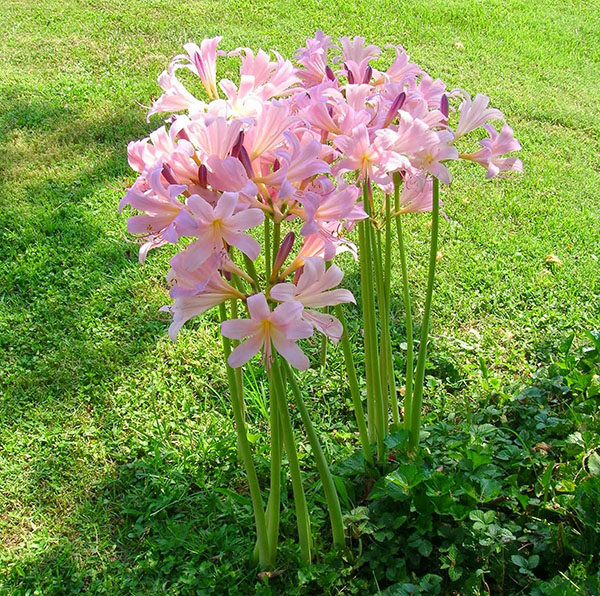 Many years have passed since then, the plant has revealed all its secrets, but even now, for some lovers of indoor crops, home amaryllis seems capricious and stubborn.
Many years have passed since then, the plant has revealed all its secrets, but even now, for some lovers of indoor crops, home amaryllis seems capricious and stubborn.
Actually this is not true. If you know some of the features of the plant and take into account its origin, amaryllis flowers will delight with enviable constancy both with their appearance and with an amazing aroma.
Proper watering, fertilization
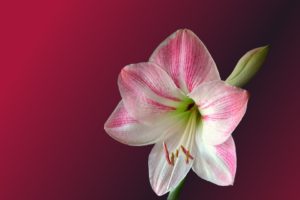
By about the end of the summer period, amaryllis comes out of dormancy. At this time, it must be transferred to a warm room and planted in nutrient soil. It is necessary to begin to water abundantly and fertilize periodically.
But this must be done carefully, do not overdo it with fertilizing, otherwise the amaryllis will begin to grow leaves and there will be a problem that the plant does not bloom. When the flower is out of dormancy, you need to water it in small portions.
And when the peduncle grows by about 7-8 centimeters, you need to increase the volume of water for irrigation. It is necessary to moisten the soil only with filtered or settled water, it can be slightly warmed up. Fertilizers need to be applied only at a time when the peduncle stretches up to 10 centimeters. You need to feed it every 10 days. It is best to fertilize with organic and mineral fertilizers, which need to be alternated. As an organic fertilizer, you can use a mullein, which must be diluted with water in a ratio of 1 to 10. With such dressings, the bush usually blooms profusely and intensively.
Features of the flowering period of the hippeastrum
The flower belongs to the genus of bulbous amaryllis plants, found naturally in South America. There are about 80 varieties and 600 hybrids of hippeastrum.

Hippeastrum does not bloom
Flowering differs in duration - up to 2 months, begins after a dormant period. After waking up, a long peduncle is thrown out - 30-85 cm, with 2 or 4 flowers, tubular or funnel-shaped, the diameter of each is 25-30 cm.
The color is diverse, there may be:
- dark red;
- orange;
- scarlet;
- pink;
- milky white varieties.
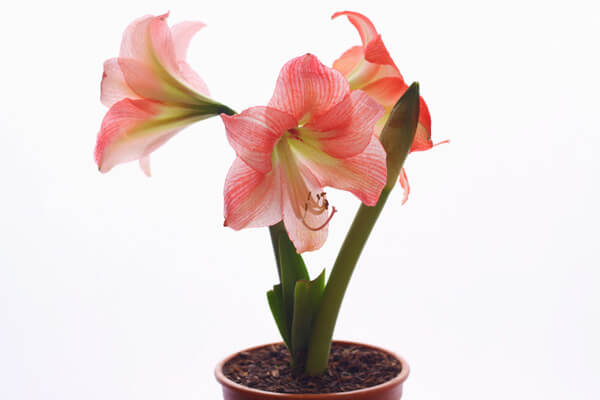
Blooming hippeastrum
Important! Favorable conditions make it possible to observe the buds every six months. For some growers, the ejection of the peduncle always occurs at the scheduled time.
How to "trick" the hippeastrum and make it bloom
Inexperienced growers for a long time cannot cope with the fact that the plant does not bloom. Why force hippeastrum to throw out flower stalks? Their appearance informs about the past period of dormancy, and if the plant does not rest, it may die. In addition, the flowers are quite beautiful and are a kind of reward for the owner of the plant for good care.
How can you make hippeastrum bloom: only by fulfilling certain conditions and rules. To obtain a peduncle, the bulb must go through a dormant period. If the plant is not going to hibernation, the leaves remain green and continue to grow, then the following procedures must be performed:
- the container with the plant is placed on its side - the hippeastrum remains in the box;
- all feeding stops, watering is minimized;
- the plant is sent to a cool and darkened room;
- a month later, the green part will fade and turn yellow - at this time, it will be pruned.
An attempt to immediately put the container in an upright position can provoke the hippeastrum to wake up from sleep. He is kept in a supine position from 2.5 to 3 months - this time will be enough for him to rest and gain new strength.
A few months later, the hippeastrum will release the first leaflet, announcing the end of the resting phase. The container is transferred to its usual place, the bulb is transplanted into fresh soil. Watering and feeding is added to the schedule again - until the fourth leaf appears. After him, they stop fertilizing the earth. If all procedures were carried out correctly, then a peduncle will soon appear.
Hippeastrum is an unusual beauty plant, with a slightly capricious character. Compliance with periods of rest in winter and activity in spring, timely moistening of the soil and mineral dressing will allow you to admire its luxurious buds twice a year.
vote
Article Rating
The presence of diseases and pests
Experts attribute insect attacks or diseases to the sources of the lack of buds. They will be discussed below.
Stagonosporosis or "red bulb burn"
It is a dangerous type of infection. Symptoms of its appearance include brownish-reddish stains and small dotted blotches. The transition of the disease to the aboveground part of the plant threatens its death.
The appearance of the first signs requires active action: the bush is pulled out of the pot and all affected areas, including 4-6 mm of healthy tissue, are cut off with a sharp disinfected knife.
Sections are treated with activated carbon powder and Funzadol, mixed in equal proportions. After cleaning the root system from soil, the plant is transplanted into the next box with fresh substrate.
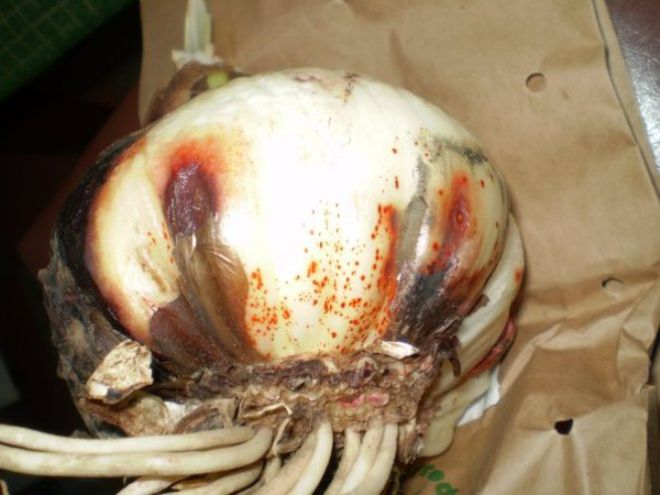
Stagonosporosis
The earth is additionally cleaned with a hot solution of potassium permanganate, the bulb is planted superficially - this will help control its general condition. After the risk of recurrence of infection has disappeared, the soil is poured into the container and the hypeastrum is continued to look after as usual.
Anthracosis and late blight
It affects the plant when it is planted in open ground. The infection develops from fungal spores, which, with sufficient moisture, easily move to healthy parts of the bush.
Attention! If the plant is mechanically damaged or there is a deficiency of potassium, then the spores spread more actively. Symptoms of the lesion are dark spots on the foliage and bulb, a decrease in their elasticity
Treatment consists of excision of all affected areas, removal of the affected leaves, and coverage of all sections with a mixture of activated charcoal and Fundazole. The soil is cleaned with 1% Bordeaux liquid
Symptoms of the lesion are dark spots on the foliage and bulb, a decrease in their elasticity. Treatment consists of excision of all affected areas, removal of the affected leaves, and coverage of all sections with a mixture of activated charcoal and Fundazole. The soil is cleaned with 1% Bordeaux liquid.
Pests
Insect attacks on the culture greatly weaken it, the result of attacks is the absence of buds, a deterioration in the general condition. If you ignore the problem, the plant quickly dies. Common pests affecting hippeastrum include:
- spider and onion mites;
- mealybug;
- shield.
To reduce the likelihood of insect damage, open soil is treated with copper sulfate before transplanting. The detected parasites are washed off with a napkin previously soaked in soapy water. If the measure does not give the expected effect, then re-treatment should be done with one of the insecticides - throughout the green part of the plant. The procedure is performed twice, with an interval of 14-21 days.

Mealybug
Important! Many problems with fungal infections and parasitic organisms are associated with attempts to plant hippeastrum in soil taken from the street.The soil from the street is almost always infected with spores and larvae; before planting, it requires sterilization with hot water and special products sold in flower shops
The soil from the street is almost always infected with spores and larvae; before planting, it requires sterilization with hot water and special products sold in flower shops.
How to groom at different times for flowering?
This plant can be made to bloom at any time by creating an artificial dormant period. If it falls in November-December, the plant will be taken care of by months as follows.
January
If the plant is dormant, no maintenance is required. Only every week you need to spray the ground with a spray bottle. At the end of January, it's time to put the pots of bulbs on the windowsill. If they've been kept in the refrigerator, it's time to plant them in pots.
February
The sun has awakened the bulbs. They wake up slowly, a flower arrow has been outlined. At this time, sometimes it is enough to spray the soil in the pot. If the length of the arrow has gone beyond 10 cm - watered and fed according to the usual scheme.
May
If necessary, you can transplant a flower or plant it in the ground when the threat of frost has passed and the temperature is at least 18 degrees. Water and feed.
August
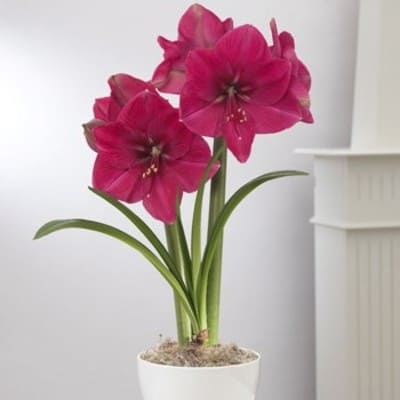 They continue to water and feed. At the end of the month, it's time to move the flower to an apartment, if it grew on the street - a cold snap can come suddenly.
They continue to water and feed. At the end of the month, it's time to move the flower to an apartment, if it grew on the street - a cold snap can come suddenly.
December
A state of deep rest. Maintenance is not required, except for spraying
Usually, such care is needed for a flower if the dormant period is artificially created. In nature, it falls in July and August, respectively, the departure schedule is shifted.




